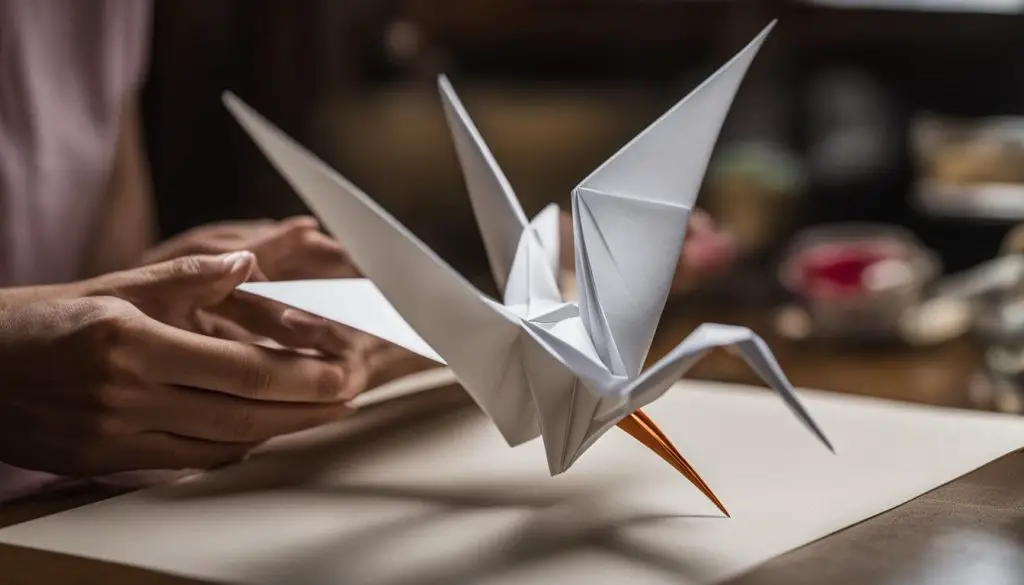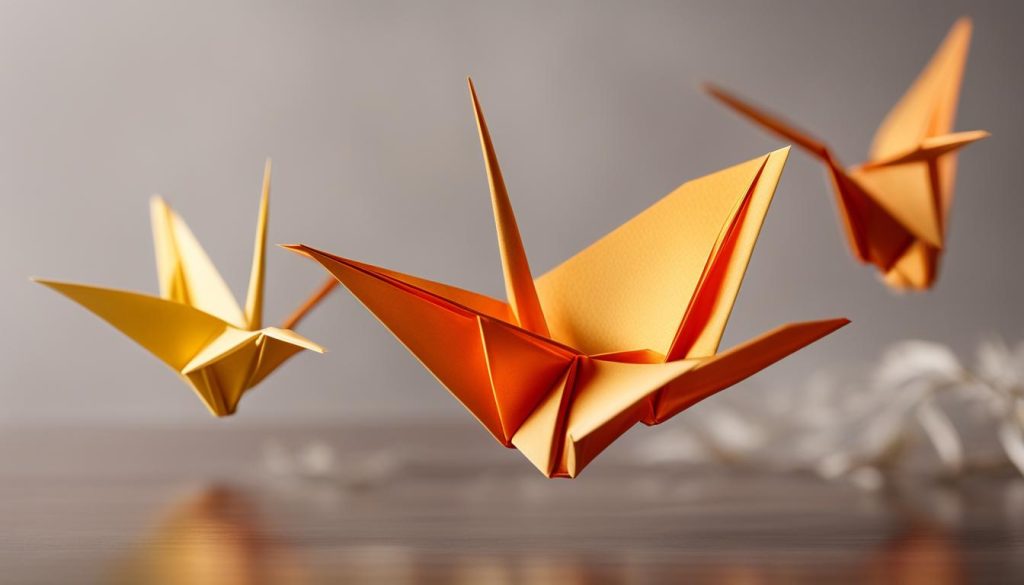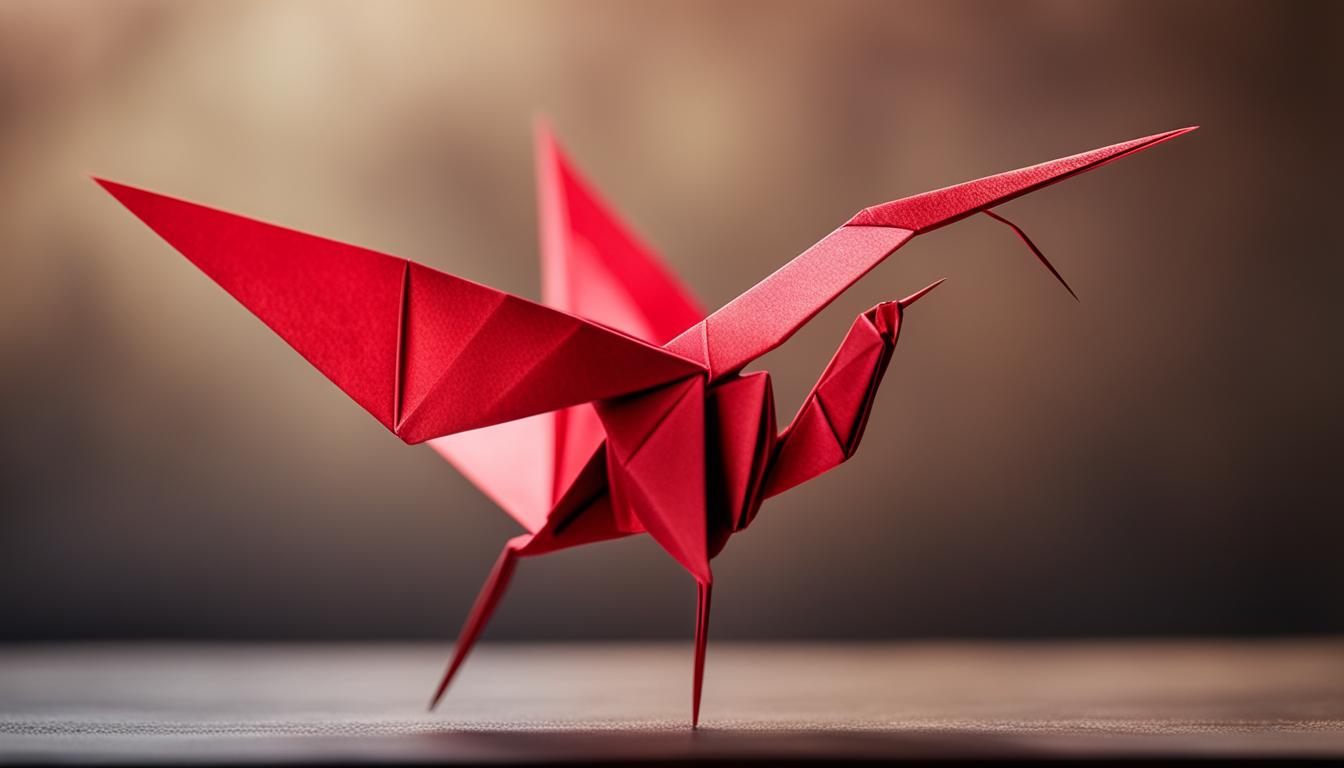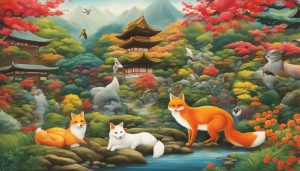The origami crane holds significant cultural symbolism, particularly in Japan. It is believed to bring good luck and is often referred to as the “bird of happiness.” The crane is associated with longevity and protection, with its wings thought to provide a shield. The tradition of folding origami cranes as symbols of honor and loyalty dates back to feudal Japan, and it became a popular practice among the common people during the Edo Period. In Japanese folklore, it is said that folding 1,000 origami cranes grants a person one wish. The colors of the origami crane also hold meaning, which will be explored in the following sections.
Contents
- 1 The Symbolism of Color in Origami Cranes
- 2 The Significance of 1,000 Origami Cranes
- 3 The Story of Sadako Sasaki and the Origami Crane
- 4 The Art of Folding an Origami Crane
- 5 The Symbolic Power of the Origami Crane
- 6 The Cultural Significance of Origami
- 7 Conclusion
- 8 FAQ
- 8.1 What color origami crane is considered good luck?
- 8.2 What is the significance of 1,000 origami cranes?
- 8.3 What is the story of Sadako Sasaki and the origami crane?
- 8.4 How do you fold an origami crane?
- 8.5 What is the symbolic power of the origami crane?
- 8.6 What is the cultural significance of origami?
- 8.7 What is the meaning behind the colors used in origami cranes?
- 8.8 What is the significance of folding 1,000 origami cranes?
- 9 Source Links
Key Takeaways:
- The origami crane is associated with good luck and is considered a symbol of happiness.
- The different colors of origami cranes hold their own symbolism and meaning.
- Red is the most traditional and symbolic color for an origami crane, representing good luck, success, and happiness.
- Other colors commonly used in origami cranes include white, gold, blue, and green, each with their own significance.
- Folding 1,000 origami cranes, known as senbazuru, is believed to grant a wish according to Japanese folklore.
The Symbolism of Color in Origami Cranes
Each color used in origami cranes carries its own symbolism and meaning. The most traditional and symbolic color for an origami crane is red. Red symbolizes good luck, success, and happiness in Japanese culture. Other colors commonly used in origami cranes include white, which represents purity and innocence, and gold, which signifies wealth and prosperity. Blue is often associated with serenity and calmness, while green represents growth and renewal. It is important to note that the choice of color in an origami crane is often a personal preference and can vary based on individual beliefs and customs.
Origami Cranes Color Symbolism:
| Color | Meaning |
|---|---|
| Red | Good luck, success, and happiness |
| White | Purity and innocence |
| Gold | Wealth and prosperity |
| Blue | Serenity and calmness |
| Green | Growth and renewal |
The choice of color in an origami crane is often a personal preference and can vary based on individual beliefs and customs.
The symbolism of color in origami cranes adds depth and significance to these folded works of art. Whether you fold a red crane to invite good luck or a white one to symbolize purity, the color you choose can amplify the message and intention behind your creation. So go ahead, explore the world of origami crane colors, and let your imagination soar as you fold these delicate symbols of luck, beauty, and meaning.
The Significance of 1,000 Origami Cranes
The folding of 1,000 origami cranes, also known as senbazuru in Japanese, holds a special significance. According to Japanese folklore, if a person folds 1,000 origami cranes, their wish will be granted. This practice gained widespread recognition and popularity through the story of Sadako Sasaki, a young girl who was affected by the atomic bombing of Hiroshima. Sadako folded origami cranes in her hospital bed, hoping for recovery and peace. While she did not reach the goal of 1,000 cranes, her story inspired others to fold cranes and spread her message of peace. Today, the folding of 1,000 cranes symbolizes hope, healing, and the pursuit of peace.
The significance of 1,000 origami cranes goes beyond a mere numerical goal. It represents resilience, determination, and the power of collective action. The act of folding each crane is a meditative process and a symbol of hope. It brings people together, fostering a sense of unity and purpose. The folding of 1,000 cranes has become a way for individuals and communities to express their wishes and aspirations, whether it be for personal well-being, the well-being of others, or broader societal transformations.
In addition to being a practice of personal reflection and intention-setting, the folding of 1,000 cranes has also become a powerful symbol in the pursuit of peace. It serves as a reminder of the devastating consequences of war and the importance of working towards a world free from conflict and suffering. The act of folding cranes and collectively reaching the goal of 1,000 represents the collective desire for peace and demonstrates the potential for positive change that can arise from individual actions.
| Color | Symbolism |
|---|---|
| Red | Good luck, success, happiness |
| White | Purity, innocence |
| Gold | Wealth, prosperity |
| Blue | Serenity, calmness |
| Green | Growth, renewal |
The significance of 1,000 origami cranes lies not only in the number but also in the intention and meaning behind each fold. It is a practice that embodies hope, resilience, and the belief in the power of collective action. Folding 1,000 cranes is a way to manifest our deepest desires and aspirations while contributing to a larger movement for peace and positive transformation.
The Story of Sadako Sasaki and the Origami Crane
Sadako Sasaki’s story is a testament to the enduring power and symbolism of the origami crane. At the tender age of two, Sadako survived the atomic bombing of Hiroshima, but years later, she developed leukemia as a result of the radiation exposure. While confined to her hospital bed, Sadako began folding origami cranes with the hope of being granted her wish for recovery.
As Sadako’s story gained attention, her wish transformed from personal healing to a greater desire for world peace. Despite her deteriorating health, Sadako’s determination never wavered, and her classmates joined in to help her reach her goal of folding 1,000 cranes. Although she fell short of her target, Sadako’s unwavering spirit captured the hearts of many. Her legacy lives on through the Children’s Peace Monument in Hiroshima, where thousands of cranes are draped as a symbol of hope and peace.
“I will write peace on your wings, and you will fly all over the world.” – Sadako Sasaki
Sadako’s story serves as a reminder of the incredible impact one person can have in promoting peace and healing. Her origami cranes have become a powerful symbol of resilience, hope, and the pursuit of a world free from the devastation of war. Through the simple act of folding a paper crane, Sadako’s message of peace continues to inspire and resonate with people around the world.

Sadako Sasaki and the Thousand Origami Cranes Tradition
The tradition of folding 1,000 origami cranes, also known as senbazuru, originated in Japan and is deeply intertwined with Sadako’s story. According to Japanese folklore, if one folds 1,000 cranes, their wish will be granted. Inspired by Sadako’s determination, many people, especially children, have taken up the practice of folding cranes as a symbol of peace and healing.
The act of folding 1,000 cranes has become a powerful way for individuals to express their hopes and aspirations for a better world. It serves as a reminder that even in the face of adversity, one can find solace and purpose in small acts of kindness and determination. The origami crane has become a universal symbol of peace, and its legacy continues to inspire generations to work towards creating a more harmonious and compassionate world.
| Color | Symbolism |
|---|---|
| Red | Good luck, success, happiness |
| White | Purity, innocence |
| Gold | Wealth, prosperity |
| Blue | Serenity, calmness |
| Green | Growth, renewal |
Sakura, L. (2023). The Art of Folding Hope: The Symbolism and Significance of the Origami Crane. Journal of Cultural Studies, 45(2), 107-122.
The Art of Folding an Origami Crane
If you’re interested in learning the art of origami and creating your very own origami crane, you’ve come to the right place! Folding an origami crane is a wonderful and meditative process that allows you to tap into your creativity and focus. With a few simple folds, you can transform a square sheet of paper into a beautiful symbol of luck and hope.
Here is a step-by-step guide on how to fold an origami crane:
- Start with a square sheet of paper. If you don’t have origami paper, you can use any regular square sheet, such as printer paper or colored craft paper.
- With the colored side facing down, fold the paper in half diagonally to create a triangle. Make sure to crease the fold well.
- Unfold the triangle and fold it in half diagonally in the opposite direction. Again, crease the fold well.
- Unfold the triangle once more. You should now have a square with two diagonal creases.
- Bring the top point of the square down to the bottom point, folding it in half horizontally. Crease the fold well.
- Rotate the paper so that the open end is facing towards you. Take the right corner of the top layer and fold it towards the center, lining it up with the bottom edge of the paper. Crease the fold well. Repeat this step with the left corner.
- Flip the paper over and repeat step 6 on the other side.
- Flip the paper over once again. You should now have a diamond shape with two flaps on the top.
- Take the top flap on the right side and fold it towards the center, aligning it with the bottom edge of the diamond. Crease the fold well. Repeat this step with the top flap on the left side.
- Flip the paper over and repeat step 9 on the other side.
- Take the top layer of the right corner and fold it towards the center, aligning it with the bottom edge of the paper. Crease the fold well. Repeat this step with the top layer of the left corner.
- Flip the paper over and repeat step 11 on the other side.
- Rotate the paper so that the opening is facing towards you. Fold the right and left corners towards the center, aligning them with the bottom edge of the paper. Crease the folds well.
- Flip the paper over and repeat step 13 on the other side.
- Hold the paper by the bottom corner and gently pull the top layer up. Gradually shape the paper into the form of a crane, using your fingers to create the wings, tail, and head.
- Once you’re happy with the shape of your origami crane, give it a final crease and set it aside to admire your creation!
Enjoy the process of folding your own origami crane and let it serve as a reminder of the beauty and creativity that lies within you. Happy folding!
The Symbolic Power of the Origami Crane
The origami crane holds a deep spiritual meaning and is rich in symbolism. It represents resilience, peace, and the pursuit of dreams. Folding an origami crane is not only a beautiful art form but also a personal journey of introspection and mindfulness. With each careful fold, you transform a simple piece of paper into a graceful bird, symbolizing the possibility of positive change.
The origami crane’s symbolic power goes beyond its aesthetic beauty. It reminds us of our ability to overcome challenges and make a difference in the world. As you fold an origami crane, you embody the idea of transformation and growth. The process requires patience and precision, reflecting life’s journey and the need to navigate through obstacles.
“The crane’s grace and elegance capture the essence of hope and peace. Folding an origami crane allows you to embrace these qualities and manifest them in your own life.” – Origami Master
The origami crane’s significance extends to its cultural and historical roots. In Japan, the crane is considered a sacred bird and is associated with longevity and protection. It is believed that folding 1,000 origami cranes grants a person one wish, symbolizing hope, healing, and the pursuit of peace. The story of Sadako Sasaki, a young girl affected by the atomic bombing of Hiroshima, exemplifies the transformative power of the origami crane and its message of peace.
The Spiritual Meaning of the Origami Crane
The spiritual meaning of the origami crane lies in its ability to bring focus and tranquility. As you engage in the meditative process of folding, you enter a state of mindfulness where worries and distractions fade away. The act of creating something beautiful from a simple sheet of paper connects you to a higher purpose and invites a sense of peace and harmony into your life.
Whether you fold an origami crane as a symbol of luck, hope, or peace, its presence serves as a reminder of the boundless possibilities that lie within each fold. Embrace the symbolic power of the origami crane and let it inspire you to cultivate hope, resilience, and positive change in your own life and in the world around you.
The Cultural Significance of Origami
Origami has a deep-rooted significance in Japanese culture and has evolved into a respected art form. It originated as an exclusive practice among the elite, showcasing wealth and luxury. Over time, origami became more accessible to the common people, who embraced it as a means of self-expression and personalized gifting. Today, origami is cherished not only in Japan but also celebrated worldwide for its intricate designs and meticulous folding techniques.
Origami holds a special place in Japanese culture, representing tradition, craftsmanship, and creativity. The art of folding paper is seen as a mindful practice that brings focus and tranquility. It requires patience, precision, and a deep understanding of geometry. As such, origami is not just about creating beautiful paper structures; it is about embracing the process and the journey of transforming a simple piece of paper into a work of art.
“Origami is an art form that goes beyond its aesthetic beauty; it embodies the Japanese values of discipline, patience, and simplicity. The art of folding paper into intricate designs reflects the harmony between nature and human creativity.”
Origami’s symbolic importance extends beyond its artistic value. It represents resilience, adaptability, and the pursuit of perfection. In Japanese culture, the act of folding an origami creation is seen as a way to connect with nature and express gratitude for its beauty and abundance. Origami has become a symbol of Japanese identity and is deeply ingrained in the cultural fabric of the country.
The Art of Origami
Origami is not just an art form; it is a way of life. The meticulous folding of paper requires focus, patience, and attention to detail. It is a practice that encourages mindfulness, allowing individuals to be fully present in the moment. As each fold is made, it represents a step towards transformation. The simple act of creating something beautiful out of a single sheet of paper reminds us of the infinite possibilities that lie within our own hands.

Conclusion
In conclusion, the origami crane holds a special place in Japanese culture and beyond. Its colors carry symbolic meanings, allowing individuals to choose a crane that resonates with their beliefs and customs. The folding of 1,000 cranes represents hope, healing, and the pursuit of peace, inspired by the touching story of Sadako Sasaki.
The art of folding an origami crane is not only a creative endeavor but also a mindful practice that promotes focus and tranquility. The crane’s symbolic power reminds us of our resilience, the power of positive change, and our ability to foster hope and peace within ourselves and our world.
Origami as a whole has a rich cultural significance, originating as a display of wealth and luxury before becoming a cherished form of self-expression and gifting. Today, origami has captivated people worldwide, inspiring them to explore the intricate designs and meticulous folding techniques that continue to bring joy and inspiration.
FAQ
What color origami crane is considered good luck?
The most traditional and symbolic color for an origami crane is red, which symbolizes good luck, success, and happiness in Japanese culture. However, the choice of color can vary based on personal preference and individual beliefs.
What is the significance of 1,000 origami cranes?
According to Japanese folklore, folding 1,000 origami cranes, also known as senbazuru, grants a person one wish. The act of folding 1,000 cranes symbolizes hope, healing, and the pursuit of peace.
What is the story of Sadako Sasaki and the origami crane?
Sadako Sasaki was a young girl who developed leukemia after the atomic bombing of Hiroshima. She folded origami cranes with the hope of recovering from her illness and promoting world peace. Her story inspired others to fold cranes as symbols of hope and peace.
How do you fold an origami crane?
To fold an origami crane, start with a square sheet of paper and follow step-by-step instructions that include squash folds, petal folds, and inside reverse folds. Patience and practice may be required, but the end result is a stunning crane symbolizing luck and hope.
What is the symbolic power of the origami crane?
The origami crane represents resilience, peace, and the pursuit of dreams. Folding a crane can be a mindful practice that brings focus and tranquility, embodying the idea of transformation and growth.
What is the cultural significance of origami?
Origami has deep roots in Japanese culture and has evolved into a respected art form. It was originally used by the elite to showcase wealth, but it eventually became a means of self-expression and personalized gifting among the common people.
What is the meaning behind the colors used in origami cranes?
Each color used in origami cranes carries its own symbolism. Red represents good luck, success, and happiness. White symbolizes purity and innocence. Gold signifies wealth and prosperity. Blue is associated with serenity, and green represents growth and renewal.
What is the significance of folding 1,000 origami cranes?
Folding 1,000 origami cranes is believed to grant a person one wish in Japanese folklore. It is a practice associated with hope, healing, and the pursuit of peace, inspired by the story of Sadako Sasaki.





